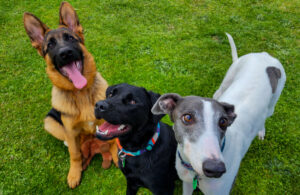Mobility Dogs: Furry Learners
By Ocean Daniel
Chapter 1 – ‘I am a Mobility Dog – I learn too’

Most people will be familiar with the L plate.
In New Zealand, it is described as a Learners Plate; used when someone is first learning to drive. Some dogs have L plates too. It also means that they are learning a new skill or permanent job. The dogs referred to are Mobility Dogs. They are specifically trained to help people who may have trouble with movement and small every day things.
These dogs quite literally ‘learn on the job.’
In many ways they act the same as a human helper would. For a person with mobility constraints of any kind, having a dog can help to create and foster independence while maintaining an inclusive environment. According to mobilitydogs.co.nz, there are a number of tasks that are part of a dog’s repertoire.
Dogs can increase interaction with others through social connection and can be welcome conversation starters. I recently sat down with Pytha (Peeta) and Elena Saunders to talk about the duties given to a Mobility Dog throughout a working day.
Chapter 2 – ‘I am working’ The Many Jobs of a Mobility Dog.
Interview: Pytha + Elena Saunders
Introducing a Mobility Dog to the big wide world takes a lot of extra energy when it comes to training. For both dogs and the people they work with, there are a lot of details to take into account. One of the things that gave me pause to think were the many specificities around this dog having a ‘job’ particularly when they are interacting within the context of the general public.
When asked about the many lessons training this kind of dog, the importance of providing time and patience was key to the shaping of a dog’s role as a future companion.
Elena reiterates that patience is a big element of the process of training.
She reflects; saying “Training the dog you have to have a lot of patience, as well as with people coming up and asking to pat them.” Generally speaking, a dog always takes time to respond to commands and Pytha adds “Its a huge learning curve… because it is quite different to having a pet dog.”

Chapter 3 – Cerebral Palsy and an early fear of Dogs
I will always give thanks and credit to these dogs for helping me with the fact that I myself had a slight fear of dogs growing up, and my family and I now own a puppy named Moose.
We had never owned a dog before we got him and so he is teaching me that dogs are not as big and scary as I initially remembered them being in the past.
He, in many ways, provides a role reversal and ‘trains me’, as a household pet dog when it comes to my response to loud noises and not enjoying them. High tone muscle function means that I have a tendency to “jump” when he barks and this causes muscle spasms in my lower legs.
Moose in my mind is ‘The dog I never knew I needed” and it is for this reason that I have now found solace in being a “dog person” which was a somewhat shockingly happy surprise. Cerebral Palsy is grouped by levels of Gross Motor Function 1 through 5. These describe the levels of Palsy by severity, and can refer to children and adults.
GMFCS – Kids – Specifies movement with/without mobility aids in and around school.
Therapy Dogs and Mobility Dogs – What are the differences: They live with a medical professional and offer emotional support. They can often be found in hospitals, or clinics to provide a safer environment for any nervous clientele.







